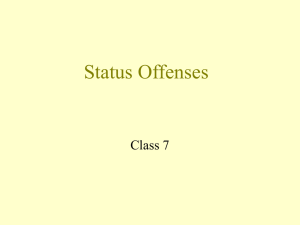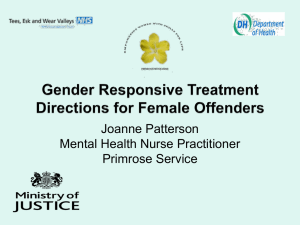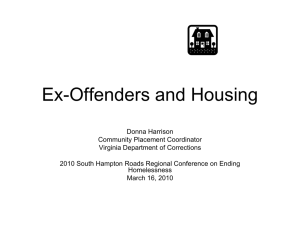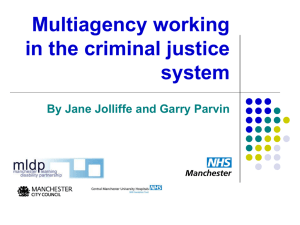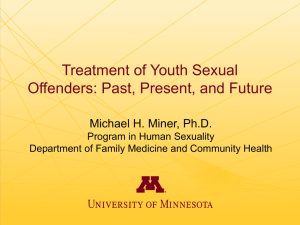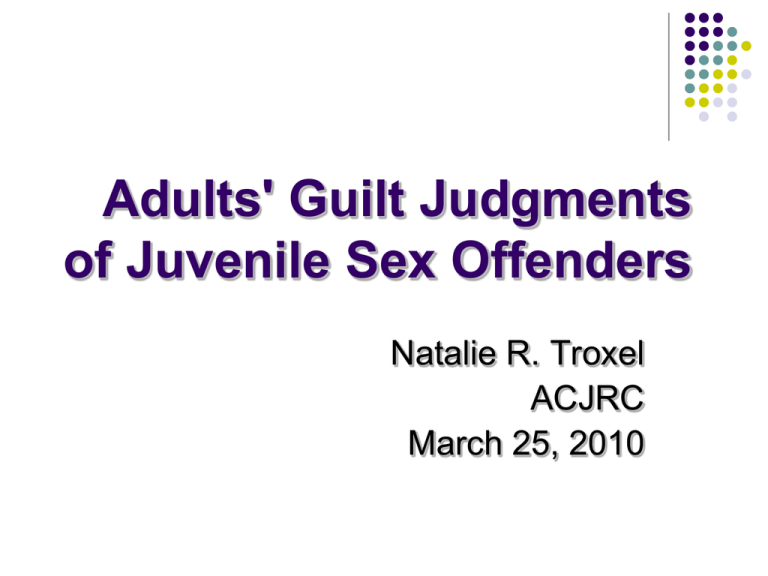
Adults' Guilt Judgments
of Juvenile Sex Offenders
Natalie R. Troxel
ACJRC
March 25, 2010
Study Goal
Perceptions of juvenile offenders
Juvenile offenders are different
Largely exploratory
Sparse literature
What is a Sex Offense?
Differs by state
Differs by culture, era
Include child sexual
abuse, child
pornography, rape, and
statutory rape
Must include intent
Offenders must register
QuickTime™ and a
decompressor
are needed to see this picture.
Who is a Sex Offender?
Anyone who commits a
sex offense
All walks of life
Usually male
Juvenile Sex Offense Rates
20% of sex offenses
15% of forcible rapes
(OJJDP, 2009)
Table courtesy of the Office of Juvenile Justice and Delinquency Prevention.
Data from 2008.
Characteristics
13-17 years old; male
(CSOM, 2000)
80% have diagnosable
mental health issue
(CSOM, 2000)
20-80% have history of
physical or sexual abuse
(CSOM, 2000)
Low repeat offense
(Alexander, 1999; Schram, Milloy,
& Rowe, 1991; Worling & Curwen,
2000)
Non-violent (Miranda &
Corcoran, 2000)
Experimentation (NCSBY,
2003)
Impulsive & immature
(NCSBY, 2003)
Photo courtesy of Walker, Walls, & Lancaster, PLC
Previous Research
Extra-legal factors (Bushway & Piehl, 2001; Everett &
Wojtkiewicz, 2002; Mustard, 2001)
Juror bias
Child witness credibility (Bottoms & Goodman, 1994;
(Carlson & Russo, 2001; Finkel, 1995; GoodmanDelahunty, Greene, & Hsiao, 1998; Kassin & Wrightsman, 1983)
Castelli, Goodman, & Ghetti, 2005; Goodman et al., 1987)
Previous Research
Perceptions of violent juvenile offenders (Ghetti
& Redlich, 2001)
Type of crime and outcome of crime influence
sentencing decisions and perceptions of
competency
Age of offenders influences competency and
accountability
Age of offenders does not influence sentencing
outcomes
Design
3 (Age: 8, 13, 17) x 2 (Force: yes, no)
Six vignettes
Age and Force are within subjects
Vignette is counterbalanced across subjects
Read vignette evaluate
Child Perpetrator (8)
Force
No Force
Young Teen Perpetrator (13)
Force
No Force
Older Teen Perpetrator (17)
Force
No Force
Sample Vignette
Steve, 7, was at a slumber party for a friend’s
birthday. The friend’s older brother, Mike, 8, was
also there. They were the only ones there who were
not interested in the movie that was playing, so they
got up to go play video games in the friend’s
bedroom. The friend’s mom walked into the room to
check on them and found that Steve was performing
oral sex on Mike. Mike had apparently told Steve
that if he did not perform oral sex, Mike would beat
him up.
Hypotheses
Older perpetrators will be judged as more guilty than
younger perpetrators (Bergeron & Mckelvie, 2004; Steffensmeier, Ulmer, &
Kramer, 1998)
Female participants (Castell et al., 2005; Quas, Bottoms, Haegerich, &
Nysse-Carris, 2002) and participants with abuse histories
(Bottoms, 1993; Waterman & Foss-Goodman, 1984) will be more likely
to vote guilty
Perpetrators using force or coercion will be judged
as more guilty than those not using force
Use of force will matter more for younger offenders
than older offenders (i.e., Force x Age interaction)
Consent
Age, F(2, 217) = 21.04, p < .001
Force, F(1, 217) = 179.30, p < .001
Age x Force, F(2, 217) = 3.39, p < .05
1=Not at all consensual
6=Completely consensual
Immorality
Age, F(2, 220) = 73.80, p < .001
Force, F(1, 220) = 117.75, p < .001
Age x Force, F(2, 220) = 10.36, p < .01
1=Not at all immoral
6=Completely immoral
Criminality
Age, F(2, 220) = 146.59, p < .001
Force, F(2, 220) = 86.55, p < .001
Age x Force, F(2, 219) = 7.74, p = .001
1=Not at all criminal
6=Completely criminal
Guilt
Age, F(2, 217) = 162.34, p < .001
Force, F(1, 217) = 72.65, p < .001
Age x Force, F(2, 217) = 5.01, p < .05
0=Not guilty
1=Guilty
Discussion
Hypotheses supported
Older perpetrators will be
judged as more guilty than
younger perpetrators
Perpetrators using force or
coercion will be judged as
more guilty than those not
using force
Use of force will matter
more for younger offenders
than older offenders (i.e.,
Force x Age interaction)
Hypotheses unsupported
Female participants and
participants with abuse
histories will be more likely
to vote guilty
Next Steps…
More data analysis!
Use Childhood Trauma Questionnaire sexual
abuse subscale
Community sample
Professional sample
Vary gender and victim’s age
Thanks
Dr. Gail Goodman
Dr. Kristin Lagattuta
Dr. Joel Johnson
Dr. Donna Shestowsky
Research Assistants



